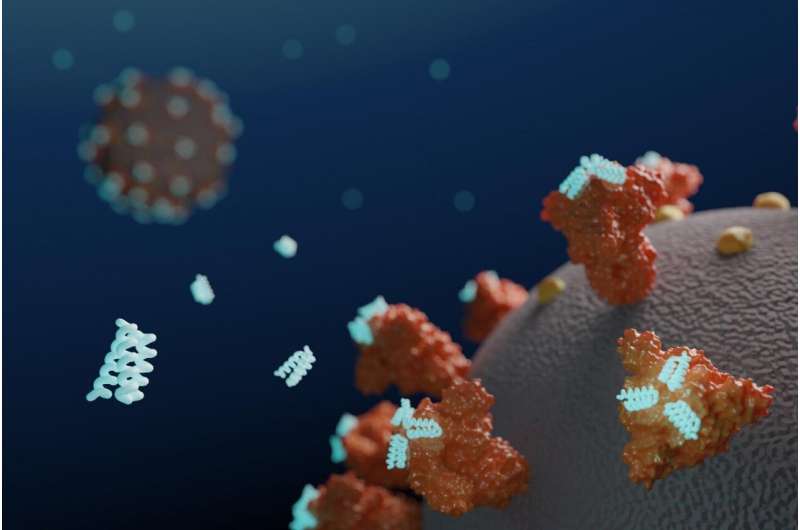Designed antiviral proteins inhibit SARS-CoV-2 in the lab

Computer-designed small proteins have now been shown to protect lab-grown human cells from SARS-CoV-2, the coronavirus that causes COVID-19.
The findings are reported today, Sept. 9, in Science.
In the experiments, the lead antiviral candidate, named LCB1, rivaled the best-known SARS-CoV-2 neutralizing antibodies in its protective actions. LCB1 is currently being evaluated in rodents.
Coronaviruses are studded with so-called Spike proteins. These latch onto human cells to enable the virus to break in and infect them. The development of drugs that interfere with this entry mechanism could lead to treatment of or even prevention of infection.
Institute for Protein Design researchers at the University of Washington School of Medicine used computers to originate new proteins that bind tightly to SARS-CoV-2 Spike protein and obstruct it from infecting cells.
Beginning in January, more than two million candidate Spike-binding proteins were designed on the computer. Over 118,000 were then produced and tested in the lab.
"Although extensive clinical testing is still needed, we believe the best of these computer-generated antivirals are quite promising," said lead author Longxing Cao, a postdoctoral scholar at the Institute for Protein Design.
"They appear to block SARS-CoV-2 infection at least as well as monoclonal antibodies, but are much easier to produce and far more stable, potentially eliminating the need for refrigeration," he added.
The researchers created antiviral proteins through two approaches. First, a segment of the ACE2 receptor, which SARS-CoV-2 naturally binds to on the surface of human cells, was incorporated into a series of small protein scaffolds.
Second, completely synthetic proteins were designed from scratch. The latter method produced the most potent antivirals, including LCB1, which is roughly six times more potent on a per mass basis than the most effective monoclonal antibodies reported thus far.
Scientists from the University of Washington School of Medicine in Seattle and Washington University School of Medicine in St. Louis collaborated on this work.
"Our success in designing high-affinity antiviral proteins from scratch is further proof that computational protein design can be used to create promising drug candidates," said senior author and Howard Hughes Medical Institute Investigator David Baker, professor of biochemistry at the UW School of Medicine and head of the Institute for Protein Design. In 2019, Baker gave a TED talk on how protein design might be used to stop viruses.
To confirm that the new antiviral proteins attached to the coronavirus Spike protein as intended, the team collected snapshots of the two molecules interacting by using cryo-electron microscopy. These experiments were performed by researchers in the laboratories of David Veesler, assistant professor of biochemistry at the UW School of Medicine, and Michael S. Diamond, the Herbert S. Gasser Professor in the Division of Infectious Diseases at Washington University School of Medicine in St. Louis.
"The hyperstable minibinders provide promising starting points for new SARS-CoV-2 therapeutics," the antiviral research team wrote in their study pre-print, "and illustrate the power of computational protein design for rapidly generating potential therapeutic candidates against pandemic threats."
More information: Longxing Cao et al, "De novo design of picomolar SARS-CoV-2 miniprotein inhibitors" Science 09 Sep 2020: eabd9909 DOI: 10.1126/science.abd9909

















